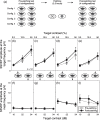Short-term monocular patching boosts the patched eye's response in visual cortex
- PMID: 26410580
- PMCID: PMC4923712
- DOI: 10.3233/RNN-140472
Short-term monocular patching boosts the patched eye's response in visual cortex
Abstract
Purpose: Several recent studies have demonstrated that following short-term monocular deprivation in normal adults, the patched eye, rather than the unpatched eye, becomes stronger in subsequent binocular viewing. However, little is known about the site and nature of the underlying processes. In this study, we examine the underlying mechanisms by measuring steady-state visual evoked potentials (SSVEPs) as an index of the neural contrast response in early visual areas.
Methods: The experiment consisted of three consecutive stages: a pre-patching EEG recording (14 minutes), a monocular patching stage (2.5 hours) and a post-patching EEG recording (14 minutes; started immediately after the removal of the patch). During the patching stage, a diffuser (transmits light but not pattern) was placed in front of one randomly selected eye. During the EEG recording stage, contrast response functions for each eye were measured.
Results: The neural responses from the patched eye increased after the removal of the patch, whilst the responses from the unpatched eye remained the same. Such phenomena occurred under both monocular and dichoptic viewing conditions.
Conclusions: We interpret this eye dominance plasticity in adult human visual cortex as homeostatic intrinsic plasticity regulated by an increase of contrast-gain in the patched eye.
Keywords: Monocular patching; contrast-gain; eye dominance plasticity; intrinsic plasticity; steady-state visual evoked potentials; visual cortex.
Figures




References
-
- Bagolini B, Falsini B, Cermola S, Porciatti V. Binocular interactions and steady-state VEPs. A study in normal and defective binocular vision (Part II) Graefes Arch Clin Exp Ophthalmol. 1994;232((12)):737–744. - PubMed
-
- Black JM, Thompson B, Maehara G, Hess RF. A compact clinical instrument for quantifying suppression. Optom Vis Sci. 2011;88(2):334–343. - PubMed
-
- Brainard DH. The psychophysics toolbox. Spatial Vision. 1997;10(4):433–436. - PubMed
Publication types
MeSH terms
Grants and funding
LinkOut - more resources
Full Text Sources

